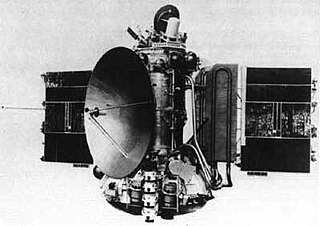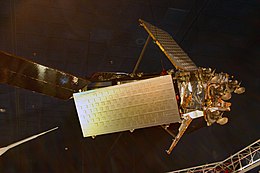
Mars 4, also known as 3MS No.52S was a Soviet spacecraft intended to explore Mars. A 3MS spacecraft launched as part of the Mars programme, it was intended to enter orbit around Mars in 1974. However, computer problems prevented orbital insertion from occurring.

Space debris are defunct human-made objects in space – principally in Earth orbit – which no longer serve a useful function. These include derelict spacecraft, mission-related debris, and particularly-numerous in-Earth orbit, fragmentation debris from the breakup of derelict rocket bodies and spacecraft. In addition to derelict human-made objects left in orbit, space debris includes fragments from disintegration, erosion, or collisions; solidified liquids expelled from spacecraft; unburned particles from solid rocket motors; and even paint flecks. Space debris represents a risk to spacecraft.
Kosmos is a designation given to many satellites operated by the Soviet Union and subsequently Russia. Kosmos 1, the first spacecraft to be given a Kosmos designation, was launched on 16 March 1962.
Strela is a Russian military communications satellite constellation operating in low Earth orbit. These satellites operate as mailboxes ("store-and-forward"): they remember the received messages and then resend them after the scheduled time, or by a command from the Earth. Some sources state the satellites are capable of only three months of active operation, but through coordination with others they can serve for about five years. The satellites are used for transmission of encrypted messages and images.

Kosmos-2251 was a Russian Strela-2M military communications satellite. It was launched into Low Earth orbit from Site 132/1 at the Plesetsk Cosmodrome at 04:17 UTC on 16 June 1993, by a Kosmos-3M carrier rocket.· The Strela satellites had a lifespan of 5 years, and the Russian government reported that Kosmos-2251 ceased functioning in 1995. Russia was later criticised by The Space Review for leaving a defunct satellite in a congested orbit, rather than deorbiting it. In response, Russia noted that they were not required to do so under international law. In any case, the KAUR-1 satellites had no propulsion system, which is usually required for deorbiting.
Strictly speaking, a satellite collision is when two satellites collide while in orbit around a third, much larger body, such as a planet or moon. This definition is typically loosely extended to include collisions between sub-orbital or escape-velocity objects with an object in orbit. Prime examples are the anti-satellite weapon tests. There have been no observed collisions between natural satellites, but impact craters may show evidence of such events. Both intentional and unintentional collisions have occurred between man-made satellites around Earth since the 1980s. Anti-satellite weapon tests and failed rendezvous or docking operations can result in orbital space debris, which in turn may collide with other satellites.

The Iridium satellite constellation provides L band voice and data information coverage to satellite phones, satellite messenger communication devices and integrated transceivers. Iridium Communications owns and operates the constellation, additionally selling equipment and access to its services. It was conceived by Bary Bertiger, Raymond J. Leopold and Ken Peterson in late 1987 and then developed by Motorola on a fixed-price contract from July 29, 1993, to November 1, 1998, when the system became operational and commercially available.

On February 10, 2009, two communications satellites—the active commercial Iridium 33 and the derelict Russian military Kosmos 2251—accidentally collided at a speed of 11.7 km/s (26,000 mph) and an altitude of 789 kilometres (490 mi) above the Taymyr Peninsula in Siberia. It was the first time a hypervelocity collision occurred between two satellites; previous incidents had involved a satellite and a piece of space debris.

The LM-700 is a satellite bus which was built by Lockheed Martin between the mid-1990s and early 2000s. Typically used for low Earth orbit communications satellites, ninety nine were built, all but one for Iridium Satellite LLC. The exception was a technology development satellite for the United States Air Force, which was never launched. In addition, two boilerplate satellites were launched on a test flight of the Chinese Long March 2C rocket.
Kosmos 53, also known as DS-A1 No.5 was a technology demonstration satellite which was launched by the Soviet Union in 1965 as part of the Dnepropetrovsk Sputnik programme. Its primary mission was to demonstrate technologies for future Soviet military satellites. It also conducted radiation experiments.
Kosmos 70, also known as DS-A1 No.7 was a technology demonstration satellite which was launched by the Soviet Union in 1965 as part of the Dnepropetrovsk Sputnik programme. Its primary mission was to demonstrate technologies for future Soviet military satellites. It also conducted radiation experiments.
Kosmos 49, also known as DS-MG No.2 was a scientific satellite which was launched by the Soviet Union in 1964. This mission used proton magnetometers to map the Earth's magnetic field and, along with Kosmos 26, represented the USSR's contribution to the International Quiet Solar Year World Magnetic Survey. The corresponding American measurements were performed by the satellites OGO 2 and OGO 4. It also conducted scientific research into the Earth's infrared flux and ultraviolet flux.

Kosmos 14, also known as Omega No.1, was a satellite which was launched by the Soviet Union in 1963. It was an Omega satellite, derived from the Dnepropetrovsk Sputnik series.
Kosmos 23, also known as Omega No.2, was a satellite which was launched by the Soviet Union in 1963. It was an Omega satellite, derived from the Dnepropetrovsk Sputnik series. It was a 347 kilograms (765 lb) spacecraft, which was built by the Yuzhnoye Design Office, and was used to conduct experiments with the use of gyroscopes to control spacecraft, for VNIIEM.
USA-71, also known as GPS IIA-2, GPS II-11 and GPS SVN-24, is an American navigation satellite which forms part of the Global Positioning System. It was the second of nineteen Block IIA GPS satellites to be launched.
USA-117, also known as GPS IIA-16, GPS II-25 and GPS SVN-33, is an American navigation satellite which forms part of the Global Positioning System. It was the sixteenth of nineteen Block IIA GPS satellites to be launched.
Kosmos 2421 was a Russian spy satellite launched in 2006, but began fragmenting in early 2008. It also had the Konus-A science payload designed by Ioffe Institute to detect gamma-ray bursts. Three separate fragmentation events produced about 500 pieces of trackable debris. About half of those had already re-entered Earth's atmosphere by the fall of 2008.
Kosmos 2394 is one of a set of three Russian military satellites launched in 2002 as part of the GLONASS satellite navigation system. It was launched with Kosmos 2395 and Kosmos 2396.







